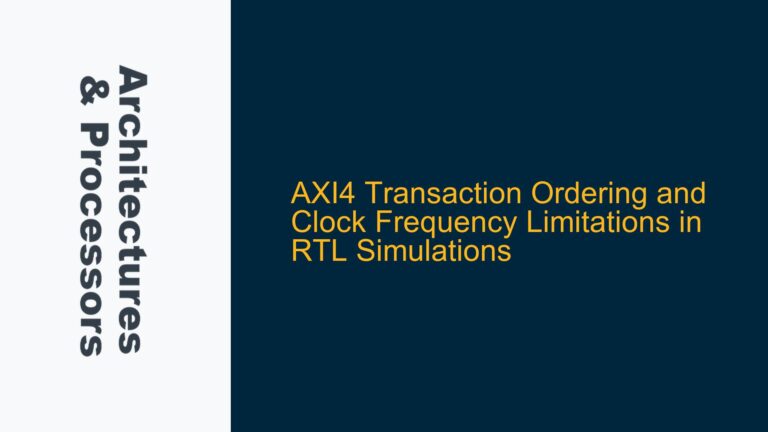ARM Fast Models and tlm_global_quantum Synchronization Mechanism
The synchronization mechanism in ARM Fast Models is heavily reliant on the SystemC TLM-2.0 standard, which introduces the concept of quantum-based synchronization to balance simulation performance and accuracy. The tlm_global_quantum API is a critical component of this mechanism, as it defines the global quantum size, which is the maximum amount of simulated time that can elapse before all components in the simulation must synchronize. This global quantum size is managed by the tlm_quantumkeeper utility class, which ensures that all components adhere to the defined quantum boundaries.
In the context of ARM Fast Models, the global quantum size directly impacts the synchronization behavior of the virtual platform, including the ARM CPU models and other peripherals. When tlm_quantumkeeper::set_global_quantum is called in the sc_main function, it sets the global quantum size for the entire simulation, including the exported virtual system (EVS) models. This means that the quantum size defined in the sc_main function will influence the synchronization behavior of the ARM Fast Models, potentially affecting simulation performance and accuracy.
The synchronization mechanism in ARM Fast Models operates by dividing the simulation into discrete time intervals, or quanta, during which each component can execute independently without needing to synchronize with other components. At the end of each quantum, all components must synchronize to ensure that the simulation state is consistent across the entire platform. This approach allows for significant performance improvements, as components can execute in parallel without frequent synchronization overhead. However, it also introduces a trade-off between performance and accuracy, as larger quantum sizes can lead to increased synchronization latency and reduced simulation fidelity.
Potential Misconfiguration of Global Quantum Size in ARM Fast Models
One of the primary challenges in configuring the global quantum size for ARM Fast Models is determining the optimal value that balances simulation performance and accuracy. The global quantum size must be carefully chosen based on the specific workload and platform characteristics, as an inappropriate value can lead to significant issues in simulation behavior.
A common issue arises when the global quantum size is set too large, which can result in increased synchronization latency and reduced simulation accuracy. In this scenario, components may execute for an extended period without synchronizing, leading to inconsistencies in the simulation state. For example, if a DMA transfer is initiated near the end of a quantum, the transfer may complete before the next synchronization point, causing the CPU to access stale data or miss updates from other components. This can lead to incorrect simulation results and make it difficult to debug timing-related issues.
Conversely, setting the global quantum size too small can also cause problems, as it can lead to excessive synchronization overhead and reduced simulation performance. In this case, components may be forced to synchronize too frequently, resulting in a significant performance penalty. This is particularly problematic in large-scale simulations with many components, where the overhead of frequent synchronization can become a bottleneck.
Another potential issue is the interaction between the global quantum size and the timing behavior of specific components, such as ARM CPU models. ARM CPU models often have internal timing mechanisms that rely on the global quantum size for accurate simulation. If the global quantum size is not properly configured, it can lead to discrepancies in the timing behavior of the CPU models, resulting in incorrect execution of instructions or misaligned memory accesses.
Configuring and Debugging Global Quantum Size in ARM Fast Models
To address the challenges associated with configuring the global quantum size in ARM Fast Models, it is essential to follow a systematic approach that includes careful analysis of the workload and platform characteristics, as well as thorough testing and debugging.
The first step in configuring the global quantum size is to analyze the specific workload and platform characteristics. This includes understanding the timing requirements of the components, the frequency of interactions between components, and the overall simulation objectives. For example, if the simulation involves frequent DMA transfers or high-speed peripherals, a smaller global quantum size may be necessary to ensure accurate synchronization and timing behavior. Conversely, if the simulation involves long-running tasks with infrequent interactions, a larger global quantum size may be appropriate to improve performance.
Once the workload and platform characteristics have been analyzed, the next step is to set the global quantum size using the tlm_quantumkeeper::set_global_quantum function in the sc_main function. The global quantum size should be set to a value that balances simulation performance and accuracy, based on the analysis of the workload and platform characteristics. For example, a global quantum size of 10000 nanoseconds is commonly used as a default value in EVS models, but this value may need to be adjusted based on the specific requirements of the simulation.
After setting the global quantum size, it is important to thoroughly test the simulation to ensure that the timing behavior of the components is accurate and that the simulation state remains consistent. This includes running the simulation with different workloads and monitoring the behavior of the components, particularly the ARM CPU models and any high-speed peripherals. If discrepancies in the timing behavior or simulation state are observed, the global quantum size may need to be adjusted to improve accuracy.
In addition to testing, it is also important to use debugging tools to identify and resolve any issues related to the global quantum size. This includes using SystemC and TLM-2.0 debugging tools to monitor the synchronization behavior of the components and identify any inconsistencies in the simulation state. For example, if a DMA transfer is not completing correctly or if the CPU is accessing stale data, debugging tools can be used to trace the execution of the components and identify the root cause of the issue.
Finally, it is important to document the configuration and testing process, including the chosen global quantum size and any adjustments made during testing. This documentation can be used as a reference for future simulations and can help ensure that the global quantum size is consistently configured across different projects.
In conclusion, configuring the global quantum size in ARM Fast Models is a critical aspect of achieving accurate and efficient simulations. By carefully analyzing the workload and platform characteristics, setting the global quantum size appropriately, and thoroughly testing and debugging the simulation, it is possible to achieve a balance between simulation performance and accuracy. This approach ensures that the ARM Fast Models operate as intended and that the simulation results are reliable and consistent.






